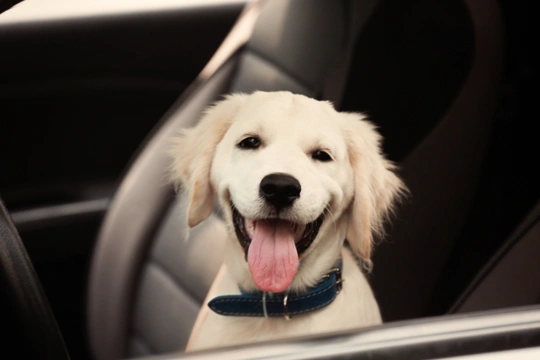
Dog and Cars in Summer
As temperatures heat up this summer, we all need to be mindful of the dangers of heat to our four-legged friends and particularly, the risks that cars pose.
Sadly, every year there are reports of dogs suffering from heatstroke or even dying from being left in hot cars. Many dog owners are unaware of the potentially catastrophic consequences of leaving their dogs in the car in hot weather. So, let's find out what the risks are to dogs in cars this summer, how to safely travel with dogs in summer, and what to do if you see a dog struggling in a hot car. As we venture out with our canine companions this summer, some planning could save your dog's life.
What are the risks to dogs in hot cars?
Dogs don’t have an efficient cooling system – they can’t sweat like humans, and they can heat up quickly. Their dense coat traps heat and has no way of escaping. Their main method of cooling themselves down is through panting but this relies on a heat gradient and evaporation so is inefficient when the surrounding temperature is high. Brachycephalic dogs – those with a flat, wide skull and a short nose such as Pugs, Bulldogs, Shi Tzus, and Boston terriers are at particular risk of heatstroke as their short noses have less area to allow heat loss.
Dogs can suffer from potentially fatal heatstroke in as little as 15 minutes. Just a 2 C increase in a dog’s body temperature is all it takes for heat stroke to kick in. Dogs overheat quickly in cars and struggle to cool themselves down. Studies have shown that opening the window has little effect on temperature and even cars parked in the shade heat up quickly. The temperature inside a car can be 10-20C higher than the temperature outside. Your dog’s body temperature and panting can make that even hotter and temperatures inside a car can exceed 40C. So, even on a cool summer’s day, it is not safe to leave your canine friend unattended in the car.
What to do if you see a dog in a car on a hot day
In the UK, it is not illegal to leave a dog in the car. However, if your pet became unwell as a result of this you could be charged with the offence of animal cruelty under the Animal Welfare Act 2006. If you come across a dog that is trapped in a hot car and is showing signs of distress and its owner cannot be contacted, then call 999 and ask for assistance. It is illegal to break into the car to free the dog and this could be classed as criminal damage. However, if you are sure the dog is in distress and could die without immediate intervention, then document your actions with photos or videos and tell the police what you intend to do and why.
If you come across a dog in a hot car that is not in distress, then monitor the situation closely. Try to contact the owner – if you are in the car park of a shop then ask the staff to put an announcement over the loudspeaker or ask in nearby buildings if anyone knows who owns the car. In the UK, you can contact the RSPCA or the police if you are concerned the animal is in danger and ask for advice.
What are the signs of heatstroke in dogs that have been in a hot car?
Dogs who are overweight or brachycephalic are more at risk of heatstroke. However, any size or breed of dog is susceptible to overheating in a short space of time in hot cars. Heatstroke can progress rapidly, and urgent intervention is required. Signs of illness might include:
- Fast, heavy panting
- Excessive drooling
- Increased heart rate
- Dark (red or purple) gums or tongue
- Signs of distress or agitation
- Vomiting
- Staggering, weakness, or collapse
- Seizures
- Unconsciousness
What should I do if my dog has signs of heatstroke after being in the car?
If you are concerned your pet is overheating in the car, then pull over and remove your dog from the vehicle. Try to find a shaded area to allow your pet to cool down. Offer them cool (but not ice cold) water to drink. Place cool water on their coat and paws to allow evaporation and heat loss. Do not cover your dog’s coat with wet towels as this prevents adequate evaporation and do not use ice-cold water as this could send your dog into shock.
If they are showing signs of distress or illness and you cannot cool them down quickly, then seek emergency veterinary care with the nearest vet.
How can I travel safely with my dog in the car during the summer?
Never leave your dog unattended in the car, even for short periods as the car can heat up quickly. Avoid long car journeys in the midday heat and try to plan your doggy adventures early in the morning or evening when temperatures are cooler. Make regular stops to offer your dog water and keep them hydrated. Keep your car cool using the air conditioning and place shades on the windows so that they are out of direct sunlight. Spraying your dog with cool water intermittently will help keep them cool and provide a cool surface for them to lie on in the car, such as a ‘cool mat’ can be useful if you need to travel with your dog during hot weather.
Dr Katherine Baldwin - The Veterinary Content Team.



